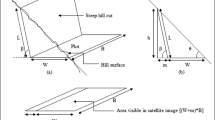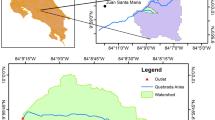Abstract
The sustainable ecological management of soil and water yields from hilly watersheds of an urban area is a real challenge from the perspective of economic and structural feasibility. It is of key importance for future city planning to implement ecological management practices (EMPs) optimally in urban hilly watersheds incorporating future urban growth. To achieve this, here, the Revised OPTimal EMP Model with Linear Programming for Single Ownership (R-OPTEMP-LS) is applied to manage the water and sediment yield calculated concerning a future LULC scenario of a hilly urban watershed of Guwahati city, India. The future LULC of the study area has been derived by using the ASEA (Assessment of Settlements in Eco-sensitive Area) model. The model parameters were input from the “Master Plan for Guwahati Metropolitan Area – 2025”. It is found that in 2025, although the sediment yield from the watershed can be managed by executing the optimal combinations of EMPs, the peak runoff will be manageable only if the rainwater harvesting system will be strictly installed along with the EMPs. The model result says that for a 36.73% increase in the urban settlement in the hilly watershed from 2015 to 2025, there is a 33.4% increase in the total cost of EMPs. The high economic investment to control the adverse consequences of urban development in the hilly areas of Guwahati city emphasizes the need for strict conservation of those ecologically sensitive areas.
Access this chapter
Tax calculation will be finalised at checkout
Purchases are for personal use only
Similar content being viewed by others
References
Chang NB, Wen CG, Wu SL (1995) Optimal management of environmental and land resources in a reservoir watershed by multiobjective programming. J Environ Manag 44(2):144–161
Das J, Jha S, Goyal MK (2020) On the relationship of climatic and monsoon teleconnections with monthly precipitation over meteorologically homogenous regions in India: Wavelet & global coherence approaches. Atmos Res 238:104889. https://doi.org/10.1016/j.atmosres.2020.104889
Flinker P (2010) The need to reduce impervious cover to prevent flooding and protect water quality. Rhode Island Department of Environmental Management, Rhode Island. http://www.dem.ri.gov/programs/bpoladm/suswshed/pdfs/imperv.pdf
Gabriel SA, Faria JA, Moglen GE (2006) A multiobjective optimization approach to smart growth in land development. Socio Econ Plan Sci 40(3):212–248
Gelagay HS, Minale AS (2016) Soil loss estimation using GIS and remote sensing techniques: a case of Koga watershed, northwestern Ethiopia. Int Soil Water Conserv Res 4(2):126–136
GMDA (2009) Master plan of Guwahati metropolitan area 2025. Guwahati Metropolitan Development Authority, Guwahati. http://www.gmda.co.in/master_plan.php
Goyal MK, Ojha CSP (2010) Evaluation of various linear regression methods for downscaling of mean monthly precipitation in Arid Pichola Watershed. Nat Resour 1(1):11–18. https://doi.org/10.4236/nr.2010.11002
Goyal MK, Ojha CSP (2012) Downscaling of precipitation on a lake basin: evaluation of rule and decision tree induction algorithms. Hydrol Res 43(3):215–230. https://doi.org/10.2166/nh.2012.040
Goyal MK, Panchariya VK, Sharma A, Singh V (2018) Comparative assessment of SWAT model performance in two distinct catchments under various DEM scenarios of varying resolution, sources and resampling methods. Water Resour Manag 32(2):805–825. https://doi.org/10.1007/s11269-017-1840-1
Hsieh CD, Yang WF (2007) Optimal nonpoint source pollution control strategies for a reservoir watershed in Taiwan. J Environ Manag 85(4):908–917
Karterakis SM, Karatzas GP, Nikolos IK, Papadopoulou MP (2007) Application of linear programming and differential evolutionary optimization methodologies for the solution of coastal subsurface water management problems subject to environmental criteria. J Hydrol 342(3–4):270–282
Kondoh A, Nishiyama J (2000) Changes in hydrological cycle due to urbanization in the suburb of Tokyo Metropolitan area, Japan. Adv Space Res 26(7):1173–1176
Kuichling E (1889) The relation between the rainfall and the discharge of sewers in populous districts. Trans Am Soc Civ Eng 20(1):1–56
Mukheibir P (2008) Water resources management strategies for adaptation to climate-induced impacts in South Africa. Water Resour Manag 22(9):1259–1276
Ng HYF, Marsalek J (1989) Simulation of the effects of urbanization on basin streamflow 1. JAWRA J Am Water Resour Assoc 25(1):117–124
ODOT Highway Division (2014) Hydraulics design manual: appendix F-rational method. Oregon Department of Transportation, Geo-Environmental Section, Salem, pp 7-F-1–7-F-14
Ozacar BG (2013) Impacts of urbanization on flood and soil erosion hazards in Istanbul, Turkey. The University of Arizona, Tucson
Patowary S, Sarma AK (2018) GIS-based estimation of soil loss from hilly urban area incorporating hill cut factor into RUSLE. Water Resour Manag 32(10):3535–3547
Patowary S, Sarma AK (2020) Projection of urban settlement in eco-sensitive hilly areas and its impact on peak runoff. Environ Dev Sustain 22(6):5833–5848
Patowary S, Sarma B, Sarma AK (2019) A revision of OPTEMP-LS model for selecting optimal EMP combination for minimizing sediment and water yield from hilly urban watersheds. Water Resour Manag 33(4):1249–1264
Poff NL, Bledsoe BP, Cuhaciyan CO (2006) Hydrologic variation with land use across the contiguous United States: geomorphic and ecological consequences for stream ecosystems. Geomorphology 79(3–4):264–285
Poonia V, Goyal MK, Gupta BB, Gupta AK, Jha S, Das J (2021) Drought occurrence in different river basins of India and blockchain technology based framework for disaster management. J Clean Prod 312:127737. https://doi.org/10.1016/j.jclepro.2021.127737
Renard KG, Foster GR, Weesies GA, Porter JP (1991) RUSLE: revised universal soil loss equation. J Soil Water Conserv 46(1):30–33
Sadeghi SHR, Jalili K, Nikkami D (2009) Land use optimization in watershed scale. Land Use Policy 26(2):186–193
San Diego County (2003) San Diego County hydrology manual. San Diego County Department of Public Works, Flood Control Section
Sarma B (2011) Optimal ecological management practices for controlling sediment and water yield from a hilly urban system within sustainable limit (Doctoral dissertation)
Sarma AK, Chandramouli V, Singh B, Goswami P, Rajbongshi N (2005) Urban flood hazard mitigation of Guwahati City by silt monitoring and watershed modeling. Report submitted to Ministry of Human Resources Department (MHRD) by Department of Civil Engineering, IIT Guwahati
Sarma AK, Giraud G, Baishya MD (2006) Rainwater harvesting for urban flood peak reduction. My Green Earth. J Soc Socio Eco Awareness Environ Prot 3(2):14–21
Sarma B, Sarma AK, Singh VP (2013) Optimal ecological management practices (EMPs) for minimizing the impact of climate change and watershed degradation due to urbanization. Water Resour Manag 27(11):4069–4082
Sarma B, Sarma AK, Mahanta C, Singh VP (2015) Optimal ecological management practices for controlling sediment yield and peak discharge from hilly urban areas. J Hydrol Eng 20(10):04015005
Stutter MI, Lumsdon DG (2008) Interactions of land use and dynamic river conditions on sorption equilibria between benthic sediments and river soluble reactive phosphorus concentrations. Water Res 42(16):4249–4260
Tong ST, Chen W (2002) Modeling the relationship between land use and surface water quality. J Environ Manag 66(4):377–393
Viessman W, Lewis GL, Knapp JW, Harbaugh TE (1989) Introduction to hydrology
Wischmeier WH, Smith DD (1961) A universal equation for predicting rainfall-erosion losses: an aid to conservation farming in humid regions. Agric Res Serv ARS Special Report, pp 22–66
Author information
Authors and Affiliations
Editor information
Editors and Affiliations
Rights and permissions
Copyright information
© 2023 The Author(s), under exclusive license to Springer Nature Singapore Pte Ltd.
About this chapter
Cite this chapter
Patowary, S., Sarma, A.K. (2023). Optimal Management of Potential Water and Sediment Yield from Urban Hilly Watershed. In: Gupta, A.K., Goyal, M.K., Singh, S.P. (eds) Ecosystem Restoration: Towards Sustainability and Resilient Development. Disaster Resilience and Green Growth. Springer, Singapore. https://doi.org/10.1007/978-981-99-3687-8_3
Download citation
DOI: https://doi.org/10.1007/978-981-99-3687-8_3
Published:
Publisher Name: Springer, Singapore
Print ISBN: 978-981-99-3686-1
Online ISBN: 978-981-99-3687-8
eBook Packages: Earth and Environmental ScienceEarth and Environmental Science (R0)




